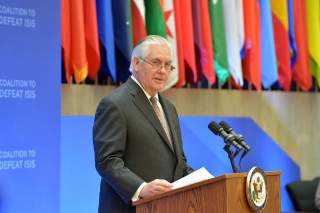Trump and Putin Hit the First Bump in the Road—and It's Called Syria
Does the Tillerson visit to Moscow represent the end of Trump’s initial approach to Russia?
Secretary of State Rex Tillerson is being sent to Moscow on an impossible mission that will test his negotiating skills, as well as the depth of the connections he forged with the Russian elite during his tenure as CEO of Exxon. When his visit was first announced weeks ago, he already had a challenging task to try and forge the lines of communication between a new U.S. presidential administration and the Kremlin—and to stop the steady deterioration that has marked U.S.-Russia relations for the past three years. Now, the events of the past week will complicate his task tenfold.
After the chemical attack in Syria, the Russians knew that the Trump administration would be forced to make some sort of response. The Kremlin’s alternative narrative—that the discharge of sarin gas came from a rebel stronghold hit by the airstrike, rather than being dropped by Syrian government forces—was unconvincing to the U.S. national-security community. For whatever reason, Bashar al-Assad or one of his commanders decided to demonstrate to the opposition forces in Idlib Province that the Syrian government might again be able to act with impunity. Moscow seems to have concluded that the Assad regime would have to absorb losses from a direct but limited U.S. strike, and at the same time hoped that it would “even the scales” and allow the planned U.S.-Russia dialogue on the future of Syria—one that the Russian political establishment has been requesting since the inauguration—to begin.
Instead, voices have resounded, not only from Congress but also from within the Trump administration itself, calling for regime change in Syria, a much more robust U.S. intervention to shape Syria’s future (without Russian participation), and a more forceful stand against both Russia and Iran—including the imposition of new sanctions. On top of the Syria problem are still very raw feelings about Russia’s role in the 2016 U.S. presidential elections and Russian policies in eastern Europe, especially in Ukraine. Tillerson thus travels to Moscow, not to start a friendly conversation but, as some have characterized it, with a mandate to confront the Russians on what Washington views as their bad and unconstructive behavior around the world. In turn, the view expressed over the weekend by Prime Minister Dmitry Medvedev on his personal Facebook page is that what is now coming out is the perspective of the “Washington establishment,” which has succeeded in overriding the perspectives of the Trump campaign to reassert a more hostile stance vis-à-vis Russia.
While the Tomahawk strike fulfills Donald Trump’s own criteria for dealing with the Kremlin from a position of American strength, he is not sending Tillerson with much leverage. If part of Tillerson’s mission was to lay the groundwork for an eventual tete-à-tete between Vladimir Putin and Donald Trump, where both men could engage in some pragmatic dealmaking (a Syria settlement, a path to resolving the Ukraine crisis and the lifting of some critical U.S. sanctions), it is clear he travels with very little support to offer anything substantive to Moscow. Certainly there is nothing to suggest that Tillerson could offer opening talks based on the proposal advanced last week by Jordan’s King Abdullah, to offer concessions on Crimea in return for dropping support for Assad. Instead, he is expected to deliver a list of U.S. complaints, and convey the message that Washington expects compliance—but can offer no guarantees of what the United States is prepared to promise in return. For all of the reporting suggesting that Trump wants to conduct a “transactional” foreign policy, the reality is that the Kremlin is quite clear in its insistence that it will do nothing on credit and vague assurances of future American goodwill.
This may explain why the promise of a Tillerson-Putin meeting, although never formally scheduled, now appears to have been revoked.
Linked to this are questions about Tillerson’s own role in the constellation of the Trump national-security establishment. When he was first selected, there was an expectation that Tillerson would be playing a critical role as Trump’s principal foreign dealmaker. But the Russians, like others closely observing the new administration, may be reconsidering how much influence the secretary actually possesses, and be concerned that others are seen as having more importance in shaping the Trump administration’s foreign-policy approach. Foreign Minister Sergey Lavrov may wonder if he may be experiencing his own version of Groundhog Day where, just as with his predecessor John Kerry, Tillerson is simultaneously negotiating with Russia while also battling for access and a hearing in the White House.
The one wild card remaining, of course, is Donald Trump himself. While others in his administration have been quite vocal, he has said very little. Is he still interested in pursuing the possibility of a cooperative relationship with Russia—and, if so, has Tillerson been given a private message to deliver to the Russian government to ignore the chatter coming out of Washington? Or has Trump been convinced by the arguments that have been presented to him that his campaign hopes for improved ties with Moscow are just not feasible now that he is president?
Thirty years ago, in The Art of the Deal, Trump noted: “I never get too attached to one deal or one approach. For starters, I keep a lot of balls in the air, because most deals fall out, no matter how promising they seem at first.” Does the Tillerson visit to Moscow represent the effective end of his administration’s initial approach to Russia?
Nikolas K. Gvosdev, a contributing editor at the National Interest, is a senior fellow at the Foreign Policy Research Institute. The views expressed here are his own personal assessments.
Image: Rex Tillerson delivers opening remarks at the Meeting of the Ministers of the Global Coalition on the Defeat of ISIS. Wikimedia Commons/Department of State

